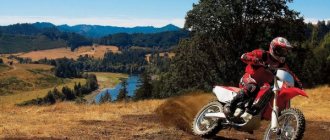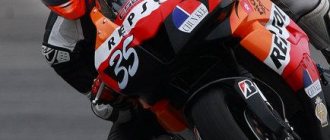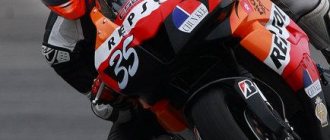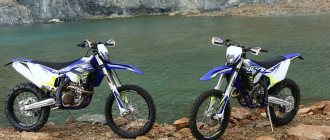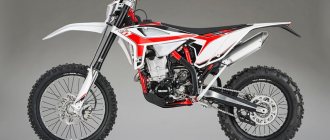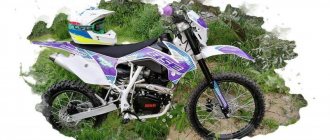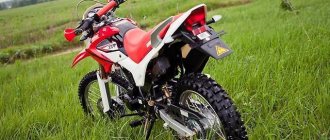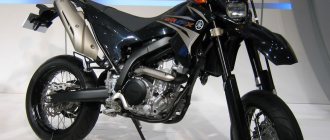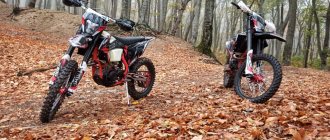What is "enduro"?
Enduro means enduring, patient, from the Latin indurare. Indeed, enduro requires endurance, patience and a serious margin of safety from both the equipment and the rider. When you encounter obstacles on rough terrain and off-road, you are required to have a fair amount of perseverance in overcoming them. Enduro is a real test of strength, both literally and figuratively.
Enduro motorcycles originally appeared in motorsports. Later, one direction was divided into several branches. In fact, there are quite a few of them, but we will analyze the largest and most interesting to us.
What is enduro? The history of the popular motorcycle movement in detail
Many people have heard the word “enduro” - this is the name for both off-road motorcycles and cross-country racing. But few people know what exactly this word means. It's actually the name of one of the most famous off-road motorcycle races. It has been held for more than a hundred years, and modern enduro motorcycles have largely become what we are used to thanks to this race...
At the dawn of the twentieth century, England and France were the leaders in motorcycle manufacturing. They gave impetus to a new sport - endurance competitions, in French - endurance.
Since 1907, the Tourist Trophy competition began to be held on the Isle of Man, and in 1908 the prototype of motocross, the Fox Chase, appeared. The International Motorcycle Federation FICM (later FIM) decided to combine both directions. The first enduro race in 1913, in the English town of Carlisle, featured several British and three French riders, and the competition took place over six days. The official name of the International Six Day Trial did not contain the word “enduro” - it appeared only in 1981, when the competition was renamed (ISDE).
From the first races until 1957, motorcycles with sidecars were allowed
From the very beginning, the competition has been held annually, with only interruptions during the First and Second World Wars. What distinguishes ISDE from other types of motorsports is primarily its team spirit. The main prize, the Nations Cup (later the World Trophy), is awarded to a national team of a certain composition. In addition to the team Trophy, others were awarded over the years. In 1923, the Silver Vase Trophy was established, but in 1985 it was abolished and the Junior Trophy was introduced for riders under 23 years of age. In 2007, the “Women’s Class” – Women’s Cup – was established. The “Factory Brand Trophy” was also raffled off among motorcycle manufacturers. Until 1970, riders could only compete in the Nations Cup on motorcycles manufactured in their own country.
The essence of the competition is to regularly move along a long route (more than 1200 km long) for six days and to win in additional speed disciplines. Additional competitions include cross-country starts, climbs, and acceleration tests. The final used to be a general road-circuit race, then it was replaced by a cross-country race.
In the early post-war years, British heavy motorcycles were still winning (pictured is a 1948 Royal Enfield)
The rules of the “six-day” are quite complex, the requirements for technology, the type and nature of the disciplines, as well as the procedure for penalties have changed several times. For this, the competition received the description of the most intellectual type of motorsport, a kind of motorcycle Olympics. It’s difficult not only for racers, but also for coaches and mechanics. In general, like chess: a game full of surprises, with many options.
POLYGON
ISDE competitions, like no other, have become a testing ground for many technical solutions. By assessing the technology launched in different years, you can trace the path of progress, see its dead-end branches, changing trends and leaders.
At the beginning of the history of the “six days”, heavy but high-quality British and French equipment dominated. Motorcycles produced in Germany, Italy, Belgium, and Sweden successfully competed with it - these countries were great motorcycle powers before the Second World War. Motorcycles were distinguished from road bikes mainly by starting plates and tubes and pumps attached to free places (the latter later replaced compressed air cans). Here are the brands that were popular in pre-war competitions: AJS, Ariel, BMW, Brough-Superior, BSA, DKW, FN, Gilera, Gnome-Rhône, Harley-Davidson, Indian, MAC, Matchless, Peugeot, Royal Enfield, Rudge, Sunbeam, Terrot, Triumph, Velosette, Zündapp. Today, most of these names are known only to motorcycle antique dealers. Motorcycles were mainly equipped with a lower valve four-stroke “single-barrel” engine, a parallelogram fork and a rigid rear suspension.
The fifties were marked by the rapid advance of “two-stroke” engines (pictured is a well-equipped Austrian Puch)
Since 1947, the Motorcycle Olympics resumed, and technology began to change very quickly. Two-stroke engines appeared on the scene, suspensions, which had not changed for almost half a century, were improved. Riders appreciated the frames with a rear swing fork and the use of “hydraulics”. New names appeared in motorsport, old companies got a second wind. The riders achieved victories on Bultaco, Laverda, Maico, and Husqvarna motorcycles. Jawa and ČZ from Czechoslovakia, Simson and MZ from the GDR played a prominent role in the 60s and 70s. And in the USSR they developed their own motorcycles, and since 1956, Soviet athletes have repeatedly participated in the FIM “six-day race” (read more about this in the next issue of the magazine). Motorcycles from Germany - Zündapp, BMW and NSU - did not lag behind. English brands have fallen into disrepair, just like classic four-stroke engines. Since 1957, the FIM has abolished the participation of motorcycles with sidecars in competitions. But small-capacity motorcycles, even 50-cc ones, were given the green light and placed in a separate class. In addition to it there were classes “75”, “100” and “125” cubic meters. see. Here the names Hercules, Puch, Sachs, Simson, Zündapp sounded triumphantly.
The seventies were marked by the almost complete victory of two-stroke engines. So, in 1974, out of 296 motorcycles in eight classes, there were only four with 4T engines. The riders from Great Britain remained faithful to them until the last, but next year they too switched to Javas with two-stroke engines. And the era of Austrian KTM motorcycles began, the success of which was greatly facilitated by the victories in world motocross of our fellow countryman Gennady Moiseev.
One of the technical wonders of the 20th century, the Wankel rotary engine was also tested in ISDE racing (pictured Hercules Wankel 1975)
The sixties and seventies were years of searching, sometimes curious and dead-end. In 1960–1961, motor scooters were included in the Polish and English teams. WFM OSA and Lambretta-175 drove well on the roads, but they were dragged through mud and fords. American Rokon Automatic motorcycles (1974) featured a continuously variable transmission and cord-operated engine start, similar to outboard engines. Disc brakes are also new. In 1975, a well-equipped Hercules Wankel motorcycle with a rotary piston engine appeared for the first time at the six-day competition. In 1977, the Canadian Can-Am 175 Qualifier, produced by the world snowmobile leader Bombardier, tried its hand.
In 1974–1975, the American team tested an unusual Rokon motorcycle with a continuously variable transmission
And in these same years, “Japanese” began to appear on the highways. One of the first signs was the Yamaha 500 Enduro with a new generation four-stroke engine. But these engines were not able to displace the “two-stroke” engines for a long time, because the latter quickly improved and gained more horsepower. They tested intake spools, reed valves, liquid cooling and electronic control systems. In the mid-70s, the power of the two-stroke engine of the most popular class “250” reached 40 hp. s., while the weight of the entire motorcycle was less than 100 kg. In the 80s, the power of the 2T unit in the “royal” class began to exceed 50 hp. With.
The FIM Organizing Committee often changed the rules of the “six-day race” - restrictions were introduced on various parameters, classes and requirements for team composition were changed. For example, since 1982, suspension travel was limited to 250 mm (they became smaller than before), the “80” class was introduced, abolishing “50”, “75”, “100” and “175”. Since the late 90s, when four-stroke engines regained their strength, they began to equate them with two-stroke engines of smaller cubic capacity, but approximately the same power. Today the division into classes looks like this: class E1 – 100–125 cc. cm (2T) and 175–250 cc. cm (4T), class E2 – 175–250 cc. cm (2T) and 290–450 cc. cm (4T), class E3 – 290–500 cc. cm (2T) and 475–650 cc. cm (4T).
The socialist countries, represented by Czechoslovakia and the German Democratic Republic, had very strong teams in the 60s and 70s, largely due to their equipment
Restored 1961 Jawa-250 and 1974 MZ-250
BY COUNTRY AND CONTINENT
To date, six-day competitions under the auspices of the International Motorcycle Federation have taken place 89 times. The first competition in 1913 attracted 162 riders, and recently the ISDE has attracted about 500 of the world's best athletes.
Initially, the country whose team won the International Trophy received preferential rights to organize the next six-day tournament. However, the 1969 FIM Congress revoked the winner's right, leaving the choice of venue to itself. This decision was quite sound, because since 1967, ISDE received the status of a world team championship, and the federation decided to give countries of other continents a chance to win. In 1973, the six-day race left Europe for the first time and moved to the United States. In subsequent years, the competition visited Australia (1992 and 1998), again the USA (1994), Brazil (2003), New Zealand (2006) and Chile (2007).
The Lambretta-175 motor scooters looked unusual against the backdrop of seasoned “cross bikes” - in 1960, racers from Great Britain rode them
The Great Britain team has the largest number of victories in team racing - 16. But all this is a triumph of bygone years - the last victory of the Foggy Albion riders dates back to 1953. The Czechs are second, with 15 victories, and these are also achievements from the times of Czechoslovakia. The Italian team has won the main trophy 14 times since 1930. In recent decades, luck has favored teams from France, Finland and even Poland. But the US team was unlucky - they never won. However, like our riders: the USSR national team never won the World Trophy.
In the 80s, Japanese motorcycles began to actively push out the traditional favorites (pictured is one of the first “Japanese” Suzuki PE250T in the Australian team in 1980)
CHILDREN ENDURO
Along with ISDE, the Maxxis FIM World Enduro Championship (WEC) has been held as a world championship since 1990. This race series replaced the FIM European Enduro Championship, which had existed since 1968. The series currently consists of eight two-day rounds, including motocross, enduro and extreme testing. Another world-class competition is the FIM SuperEnduro World Championship. These spectacular races take place in a stadium where a dirt or sand track is laid out with obstacles of a mostly natural nature (rocks, logs, water areas, etc.) similar to those found on a classic enduro track. Competitions related to enduro include country crosses, enduro crosses, extreme enduro, bajas and rally raids. But this is a topic for another conversation...
Enduro of the early 80s: air cooling and drum brakes have not yet sunk into oblivion
In the foreground is the Italian motorcycle SWM-250
Materials were used from the book by P. Husak “Enduro Yesterday, Today, Tomorrow”, as well as those posted on the website speedtracktales.com. Special thanks to the President of the NRMF, MSMK Grigory Shulik for consultations and materials provided
Enduro classification
Soft enduro
Other names: light enduro, light enduro, soft enduro, lite enduro.
Motorcycles of this class are also called dual-purpose motorcycles. They are designed for driving both on asphalt and off-road. As a rule, these are motorcycles with a title. They are ideal for driving in rural areas, trips to nature and fishing, driving on light off-road conditions, and dirt roads. In addition, they perform well when driving on asphalt, especially when the quality of that same asphalt leaves much to be desired. You can easily overcome potholes and curbs with them.
Differences between universal enduro and cross bikes:
- More weight
- Less power
Videos from rides that Chinese enduro bikes handle just fine.
Hard enduro
Other names: extreme enduro, hard enduro.
Hard enduro motorcycles are designed for serious off-road use. The full capabilities of these motorcycles are revealed by experienced riders on “insurmountable” off-road sections - long climbs, rocks, narrow forest paths - this is their element. Motorcycles are more reliable. The suspension is energy-intensive and soft. There is an electric starter that makes life easier in difficult areas.
Motorcycle Features:
- Advanced cooling system that helps with long rides at low speeds
- The seating position is lower than that of motocross motorcycles
Mileage, like motocross motorcycles (and pit bikes), is measured in engine hours. Given the more severe operating conditions, these motorcycles have to be serviced more often.
Video from hard enduro race in Georgia to give you an idea 
Cross motorcycles
Other names: motocross, cross-country
We put hard enduro and cross country next to each other, and this is no coincidence. In fact, they are often confused. But these are really different types of motorcycles. Cross-country shoes are designed for participation in sports competitions on cross-country tracks. They have a stiff suspension to withstand jumps, they do not have an electric starter, because it is not needed, just as the headlight and other electrics are not needed. All for the sake of lightening the design, because this is sports equipment and it is intended for racing.
Key Features:
- Stiff suspension settings for jumping
- Cross racing engines produce maximum power at higher speeds
- In order to reduce weight, there are no lighting equipment or batteries, the cooling system is as light as possible
- There is no electric starter - the motorcycle starts once before the race, and if it stalls, it loses
- Sharp steering
- The seating position is as high as possible for the sake of cross-country ability, while even a tall person cannot always confidently reach the ground with both feet
Thus, it becomes clear. Cross-country motorcycles for passing sports tracks with jumps and turns at maximum speed in the shortest possible time. Hard enduro bikes for off-road/mountain/rugged terrain/difficult long climbs. It's not uncommon at a hard enduro event to spend time queuing with other bikers, watching your opponents try to get up the hill.
There are enough such episodes in this video.
Touring enduro
Motorcycles of this class are designed for traveling without restrictions. They have a comfortable fit for comfortable driving over long distances, a large power reserve, energy-intensive suspension, and off-road tires. They are comfortable enough for driving around the city too. You can find a lot of additional equipment on them: protective bars and grilles, saddlebags, windshields, headlights - the list goes on and on.
They are so popular that in some countries they occupy leading positions in terms of sales in absolute terms.
Usually these are heavy, powerful motorcycles. And their main disadvantage is their weight. It’s quite difficult to lift more than 200 kilograms, and falls always happen off-road.
The Expert-Moto motorcycle showroom does not have purebred touring enduros. However, there is a good and, most importantly, budget alternative - Bajaj motorcycles - coming straight from India, from the same factories where KTM motorcycles are produced. Dominar, Pulsar and Boxer - all three models can become your ticket to the world of motorcycle travel. For example, watch this video. 15 hours on Dominar on not the smoothest roads.
Comparative table of motocross and enduro motorcycles.
| Cross | Enduro | |
| Engine | 1-cylinder | 1-2 cylinder |
| Cooling system | dry sump | air-oil |
| Carburetor | Kick starter | electronic injection |
| Minimum ground clearance (mm) | Up to 400 | Up to 300 |
| Dry weight (kg) | Up to 100 | More than 100 |
| Rubber | large spikes (ground) | dual-purpose lugs (designed for driving on both soil and asphalt) |
| Suspension | hard (for riding while standing) | soft, designed for riding while sitting on the seat, rather than standing on the footrests |
| Brakes | weak brakes | More powerful brakes, often with petal discs |
| Exhaust system | forward flow (loud exhaust) | normal muffler |
| Other | absence of instrument panel and lighting equipment, battery and electric starter, small tank | the presence of a trunk, seats for riding together, a large tank, a set of lighting equipment and a battery |
Enduro. Advice from experienced people.
The main idea of this article is to help newcomers to enduro find answers to the most frequently asked questions. Mikhail Gavrilov and Danila Chernyaev act as expert opinions. Although in some cases their opinions differ, we hope that this article will be useful to you.
Why choose enduro?
Danila : I tried to choose a huge number of sports, but settled on enduro. Physical activity, adrenaline of racing, the pleasure of driving a motorcycle combined with various natural landscapes - such a combination is not found in other sports areas.
Mikhail : enduro is cool because you constantly interact with nature. This is a real physical activity sport that is not tied to a gym or a specific location. You can travel anywhere in the country with your motorcycle, communicate with people, and discover new landscapes every time. And here, it seems to me, the load goes on absolutely all parts of the body. As a result, we have a sport that not only keeps you physically fit, but also brings a huge amount of pleasure. Moreover, Enduro is accessible to virtually everyone. And ease of participation in competitions. Anyone can buy a motorcycle and immediately go to the Russian championship. It is clear that without preparation the results will be predictable. But this is not possible in all areas of motorsports.
Where should a newbie start? Which motorcycle to choose? What to train first?
Danila : you need to start with motocross. And specifically with the coach. He will put the correct stance, cornering, and correct jumps. I believe that motocross is the basis of enduro. Now there are quite a few cross-country schools that provide equipment for training. You can take the initial course without even buying your own motorcycle, and I think it’s necessary. Regarding the purchase of my first enduro, I would choose either the top Chinese or the old simple Japanese. Such as TTP, jebel and others. They can teach basic skills with minimal maintenance costs.
Mikhail : Well, I wouldn’t recommend buying a cool, powerful motorcycle right away. The best option would be 250-350 4t, 200-250 2t. I would advise buying modern motorcycles. From 2021. They weigh little, the engines are efficient and responsive, and they have good brakes. If you take old motorcycles, then you need to be prepared for constant repairs of all components. Plus they are heavy and often the suspensions and brakes are no longer up to standard. Something simpler, but fresher is better. You must first start driving along paths, paths, and after getting used to the technology, try to overcome various simple obstacles. If everything goes well, then try to set yourself more difficult tasks. It is important not to focus on the same thing. I worked it to perfection and went looking for something higher, bigger, more complex. This is the only way there will be progress.
Danila Chernyaev
How to prepare a motorcycle for enduro?
Danila : Well, at a minimum, it is necessary to install a standard set of protections - protection for hands, crankcase, and if 2 tons, then for the exhaust. I personally carry out maintenance before every race - I lubricate the chain, saturate the air filter, clean the fork seals, change the oil.
Mikhail : the motorcycle must be ready for every trip. There are trainings that are far from the city. Imagine - I went down into the canyon and broke down there. And that’s it, you walk back for help, and sometimes you even stay overnight. There should be no leaks, broken levers, or other technical problems. Brakes, engine, wheel bearings - all need to be serviced. You must have confidence in your motorcycle. Take with you a minimum set of keys, and little things that can be fixed on the spot - clutch levers, gearbox tabs, chain locks, etc.
Regarding attachments - protection of the front and preferably rear brakes, protection of the clutch cover, protection of hands is mandatory. Radiator protection is also a must—every fall can damage them. Regarding the fan, I would definitely recommend installing it on 2t, although it is also advisable to install it on 4t. Repairing an overheated engine will in any case be more expensive than a forced radiator cooling kit.
What equipment should I take?
Danila : In terms of equipment, you need everything. Starting from boots to motorcycle shorts. When choosing between a turtle or a shell, I choose the shell. It does not hinder movement, while protecting the main organs and back. There is a controversial issue regarding neck protection. On the one hand, there are no such speeds and jumps as in motocross, but at the same time the thing is quite important. I haven’t tried it myself, I don’t know how I’ll feel in it, but just in case, when acquiring the pace in enduro, I would advise you to try to train in it - it won’t hurt.
Mikhail : the main points in equipment are, of course, a good helmet and goggles. Knee pads are a must. And take the best ones. Knee repair will in any case cost more than the most expensive knee braces. Don't skimp on this. Knees are a very problematic part of the body if you injure them. I don't think elbow pads are necessary. Beginners often try to wear as much plastic as possible. But when you start participating in competitions, they begin to interfere. They slide, squeeze and stuff their hands. And it doesn't have a very good effect on the ride. Between a turtle or a shell, you should choose the shell. The turtle has a lightning bolt in the middle - this is its weak point. And it hinders movement + again the problem of elbow pads. Everyone, with the acquisition of experience, throws out the turtle and buys a shell. It's not hot, it's comfortable, and it performs its basic functions perfectly. Well, motorcycle boots - they should be good and not soft. Otherwise there will be broken fingers. Don't buy Chinese motorcycle boots! They tear quickly, do not hold water, and often, most often, they do not provide adequate protection.
Physical preparation for enduro.
Daniil : To be honest, there was no such problem as lack of physical fitness. I don't know what to recommend. In my experience, in the winter I train with a CrossFit trainer. In the summer I ride a motorcycle so often that this is enough for me to stay in shape. If you feel a lack of physical fitness, I advise you to combine strength exercises with cardio for endurance. You will have to pick up your motorcycle after falling on a rock quite often. The body is already under stress from high loads during the race, and then there is the lifting of 100 kilograms in far from the most comfortable conditions. Well, the correct riding technique. If you have the right technique and don’t hang on the handlebars like on a horizontal bar, this saves a lot of energy. I know it from myself.
Mikhail : here I believe that physical training can be of any kind. Here you need to distinguish what you want. If you ride once a week or twice a week just through the forest, then you don’t need much. Enough strength to lift the motorcycle when it falls. If you want to go to competitions, then you need to connect the gym and endurance training. In racing, the body works to the limit. In any case, I speak for myself. But there are situations when you just want to switch off and do nothing. Any workout will be necessary here: be it CrossFit, cardio, or even just horizontal bars. You need to include all possible workouts.
Which competitions should you go to first?
Danila : Well, in Russia, almost any race is suitable for a beginner. Go to the first race you come across in the light or hobby class. They are everywhere. I don't see any problem in this.
Mikhail : I believe that you can go to virtually any competition where there is a “light” or “hobby” class. Drive it first, try your skills, how your body copes with the race. If these classes are easy, then you need to move on to other classes. There is no need to get hung up and stay in the easy class, otherwise the level will remain in the same place. When you get more difficult conditions, then your level increases accordingly.
What to strive for?
Danila : you should always strive for success! And fulfilling the tasks set for yourself.
Mikhail : well, it depends on what the goal is from Enduro. If you strive to compete, then there should be another task. It’s not easy to go out 2-3 times a week. Gym, regular training on a motorcycle. And each time set new goals for yourself: participation in a more difficult class at competitions, practicing new elements, etc.
Chinese enduro
The range of Chinese enduro motorcycles is wide, and the price range is even wider. You can buy an enduro for 60-80 thousand, or for 250-280 thousand. How to understand all this diversity and choose something for a beginner?
How to choose a Chinese enduro motorcycle
Let's set some introductions. Firstly, it is quite difficult for a beginner who has no experience riding a motorcycle to initially decide on the type of motorcycle. If you have clearly decided that you need an enduro, then move on.
Important points: the height of the driver and the weight of the motorcycle. A short beginner, of course, will be more comfortable on a low motorcycle, on which he can reach the ground with his entire foot. Let's keep this in mind.
The most important criterion is perhaps the price. Especially for a beginner. After all, you still need to purchase equipment, which is very expensive.
So, let's break down enduro bikes into price ranges and see what's interesting about them.
Up to 100,000 rubles
BSE Z1
This motorcycle with 19/16 inch wheels is perfect for a short beginner. In terms of dimensions, it is between pit bikes and enduro motorcycles. Thanks to the low seating position, you will confidently reach the ground with your feet and feel comfortable off-road. The motorcycle has a 150 cc engine, but it is quite torquey, its power is enough even to overcome climbs.
Price: 79,990 rub. This is a great inexpensive enduro bike for a short beginner.
BSE J1/J2
This motorcycle is already more serious. Wheels 21/18, 250 cubes. It rides more cheerfully, but the seating position is also higher. Good off-road tires, 17 hp, good grip and traction.
Price: about 100 thousand depending on the configuration.
Motoland Enduro ST 250
A bright representative of universal enduro. There is a PTS, all the lighting equipment accordingly. Wide comfortable seat, soft energy-intensive suspension, balancing shaft - minimum vibrations from the engine.
A good option for those who have not yet decided - on-road/off-road - or just need a universal motorcycle for leisurely, non-extreme trips that will go anywhere. Comfortable ride for two.
Price: 88,900 rub.
Kayo K1 250 MX
New motorcycle for 2021. Fits well at a height of 170 cm, both legs confidently reach the ground. In general, the fit is similar to a pit bike. An excellent option for price-quality. Lightweight, weighing only 105 kg.
Price: 99,990 rub.
Lifan LF200GY-3B
Dual purpose motorcycle. Available in two variations: on road and off-road tires. There is a PTS, you can register it. 200 cc, 14 hp Accelerate a motorcycle to 100 km/h using GPS. A fairly large tank volume of 9.5 liters.
Price: 84,900 rub.
From 100,000 to 150,000 rubles
BSE Z5
A motorcycle worth paying attention to. There are several modifications that differ significantly in price: with the ZS 172FMM and ZS166 FMM engines. A motorcycle with a fairly high seating position. It is unlikely to be suitable for beginners with short stature, but tall beginner endurists will appreciate the fit.
Price: 124,990 rub.
KAYO T2 MX
An excellent motorcycle from a reputable Chinese brand. Two variations: with and without PTS. Accordingly, this is a cheaper version without PTS. There are also no suspension adjustments, the motorcycle is slightly higher. An excellent option if you don’t need to travel on public roads.
Price: 111,990 rub.
KAYO T2 ENDURO
Big brother of T2 MX. It differs not only in the presence of PTS. A completely different motorcycle. There is an adjustable suspension, a larger tank volume, and a different seat.
Price: 139,990 rub.
Of course, these are not all Chinese enduro motorcycles. There are more than 70 models in our catalog alone. By the way, you can get acquainted with them in the Cross/Enduro section.
Why should you choose Chinese enduro? That's why:
- Reliability. The Chinese have taken a step forward in the quality of their products. It has become objectively more reliable.
- Power. A 250 cc engine is enough to experience all the delights of enduro.
- For larger amounts you can get both 300 and 450 cc “Chinese”.
- Maintenance cost. You are buying a new motorcycle. With proper operation and timely maintenance, you will spend a minimum on caring for your motorcycle.
- Available spare parts. Motorcycles are produced here and now, as are spare parts for them.
- Low price. Chinese motorcycles are really cheap. And the money saved can be spent on equipment.
Hi all. I would like to share a video of my weekend enduro rides and express some thoughts about soft enduro as a first motorcycle.
First, a few thoughts about why I chose a Japanese 18-year-old 250cc enduro as my first motorcycle. cm and a power of approximately 30 hp.
It all started when traffic jams started to bother me. I began to spend too much, in my opinion, time and nerves on the way to work. And in our glorious city of St. Petersburg, there were more and more motorcycles - and it was pointless to ignore the fact of their existence. As well as the fact that they don't get stuck in traffic jams. As well as the fact that this is a very dangerous form of transport. It was enough to look at the reports.
It also coincided that a lot of motorcyclists began to appear around me - either the bosses, then their partners, or the driver of a corporate transport... I was able to communicate with some, express thoughts about how unsafe it all was and wag my finger at my temple at remarks about that a broken rib from a fall is essentially a scratch...
But in the end, this topic still interested me. And as a reasonable and cautious person, I began to study it from afar. First of all, I was interested in safety.
Being a person far from the motorcycle theme, I thought that there were two types of motorcyclists - brutal guys on cool chrome “choppers” and kamikazes on plastic rockets. With corresponding conclusions about the safety of this or that type of motorcycle and the riding styles of certain motorcyclists.
Naturally, after studying the statistics, reading motorcycle forums, incl. and Bikepost I wanted a “chopper” (which is actually a cruiser, but let it continue to be a “chopper” in my story). Moreover, in terms of build, in general, a chopper would suit me. Looking ahead, I will say that even if my friends saw me on a motorcycle, it was only on some kind of Harley.
As a result, after much thought, I went to a motorcycle school and opened a category literally a week before they stopped accepting self-preparation exams. I opened the category to “let it be.” Because It was autumn, and it seemed to me that it was pointless to buy a motorcycle then. And I really had nowhere to store it.
While I was going to motorcycle school, I began to look closely at four hundred cars like Drag Star, Steed, etc. I didn’t even consider large volumes, having understood from motorcycle forums that you need to start with small volumes, gradually increasing the cubic capacity. (By the way, I still have this opinion). When I asked the instructor about motorcycles of this type, he advised me to look either towards classics or enduro. Moreover, many of those around him are switching to endurics. But somehow I didn’t really pay attention to his words, of course, taking them into account, but the desire to look like a brutal man on a chrome-plated chop was stronger.
However, one incident changed everything radically. And it was like this. I went into another motorcycle dealership selling used motorcycles from Japan. It so happened that the seller was not there, but there were only mechanics from the motorcycle service center at this salon, one of whom gladly offered to sit on the motorcycle models I liked and tell me about their features. Well, I sat on Draga, on Steed, on Intruder... Of them, I liked (and only insofar as) Draga... But the mechanics of them were recommended by Intruder... in general, I still didn’t understand then what I liked about them and in general, how would I ride them... And then I jokingly said that the instructor recommended enduro to me as a first motorcycle... It turned out that this mechanic himself rides a Digrik, his wife is also an endurist, and in general, from that moment on the guy was not there stop the XR250R - I sat on it - in principle, nothing so bad, I liked it.
And it was like this. I went into another motorcycle dealership selling used motorcycles from Japan. It so happened that the seller was not there, but there were only mechanics from the motorcycle service center at this salon, one of whom gladly offered to sit on the motorcycle models I liked and tell me about their features. Well, I sat on Draga, on Steed, on Intruder... Of them, I liked (and only insofar as) Draga... But the mechanics of them were recommended by Intruder... in general, I still didn’t understand then what I liked about them and in general, how would I ride them... And then I jokingly said that the instructor recommended enduro to me as a first motorcycle... It turned out that this mechanic himself rides a Digrik, his wife is also an endurist, and in general, from that moment on the guy was not there stop the XR250R - I sat on it - in principle, nothing so bad, I liked it.
By the way, my friend, who later helped me choose a motorcycle riding a Gus 1200, also unequivocally said that the 250 cc enduro is the best choice for a beginner.
Then there was the agony of choosing a motorcycle, there was a limited amount of money, at first we looked at Hondas, but then someone suggested I look at Yamahas - they are cheaper, but otherwise almost the same as Hondas...
In general, the choice was made, the motor was found in excellent condition and purchased. Equipment for it was gradually purchased. The first few rides I rode in my buddy's butt helmet, his "spare" Alpinstar knee pads - and that's it. I consider myself lucky that I didn’t break anything during this time, because... fell off the road several times. And on the first trip I caught wobbling on the asphalt at a speed of 80 km/h - but, because... I read the theory, understood what needed to be done - I gave the gas and leveled the engine.
Then I bought motorcycle boots, a turtle, an integral helmet, gloves, Thor Force knees, and later motorcycle pants and a motorcycle jacket - thus putting together a full road outfit for myself. Later I bought a jersey, a motocross helmet with a mask and textile gloves - purely for off-road riding.
I also rode a motorcycle in winter - up to minus ten the temperature was quite comfortable for riding, and riding on snow and ice, in addition to the feeling of the motorcycle, gives an indescribable sensation. Needless to say, what would I do in winter if I bought a chopper?
In general, I have never regretted that I ride enduro. The all-season capability of the motorcycle alone is worth it! Thanks to these three strangers who influenced my choice!
Well, now, in fact, now we can show a little video with comments.
I’ll start with the most serious fall for me (I hope, the only one of its kind in terms of severity for me). The reason is that after the winter season I felt like a tough crossman and decided to skid through a turn on dense gravel. To do this, I blocked the rear one in order to break it into a skid and open the gas to start a controlled drift... But I never got to the second phase. I caught something like a highside, but because of the low speed I was not thrown out of the saddle, but simply overturned. My foot was twisted inward 180 degrees and covered with a motorcycle. If it weren't for motorcycle boots, I would have broken my ankle. As a result, I limped for a week, my ankle still hurts and once again reminds me in some situations that I’m not on a bike and I’m not so invulnerable. After this fall, some of the euphoria about my motorcycle riding wore off and my riding began to focus more on safety. Now, falling from a motorcycle even off the road, even if you fell without consequences at all, I don’t see much fun. And I try not to fall. Although, it happens.
By the way, while I was riding on universal tires, I didn’t go particularly “deep” into the pampas and it would be a stretch to call these trips interesting. Of course, I was a fan, but I couldn’t go where I wanted. Especially after the winter season, where the hand-studded Petroshina made it possible to choose the direction and just go wherever the eyes lead.
However, my life changed with the installation of “toothy” cross-country tires, on which I ventured onto the enduro track in the village of Razmetelevo near St. Petersburg. And now I have a riding companion on the KLX250 - the ride has become much more fun. After all, if something happens, someone can call an ambulance to help pull out a stuck motor, for example.
Video from his camera on this track:
Actually, now I have a “taste” of enduro, I had no idea that a motorcycle is capable of this, and you can ride it almost anywhere - it all depends on your level and how ready you are to unleash the potential of your iron horse. Even if it’s small and “weak”.
In general, now I am busy improving myself in terms of riding technique, I still have a lot to learn and I think that the “checkmarks” will be enough for me for a long time. (I still can’t master the same riding in a standing position 100%). For now, MAPED can do more than I can. But, because Mots is not angry, easy and friendly, it allows me to drive off-road wherever I want and get great pleasure from it. And on the road it can also be used as a means of transportation - driving to work on it is quite pleasant - traffic jams are cleared without problems, the motor is high and the viewing point is higher than the roofs of cars and SUVs, which allows you to view the situation several cars ahead. But still, his real element is off the road.
Actually, here’s another ride that brought a lot of fun and sometimes adrenaline. It's during rides like these that I realize how glad I am to be riding enduro.
